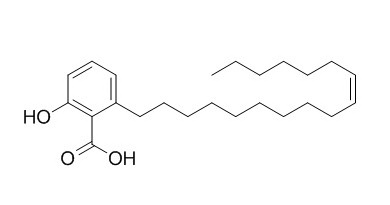Ginkgolic acid C17:1
Ginkgolic acid C17:1 can significantly inhibit enterohemorrhagic Escherichia coli O157:H7(EHEC) biofilm formation on the surfaces of polystyrene and glass, and on nylon membranes.
Inquire / Order:
manager@chemfaces.com
Technical Inquiries:
service@chemfaces.com
Tel:
+86-27-84237783
Fax:
+86-27-84254680
Address:
1 Building, No. 83, CheCheng Rd., Wuhan Economic and Technological Development Zone, Wuhan, Hubei 430056, PRC
Providing storage is as stated on the product vial and the vial is kept tightly sealed, the product can be stored for up to
24 months(2-8C).
Wherever possible, you should prepare and use solutions on the same day. However, if you need to make up stock solutions in advance, we recommend that you store the solution as aliquots in tightly sealed vials at -20C. Generally, these will be useable for up to two weeks. Before use, and prior to opening the vial we recommend that you allow your product to equilibrate to room temperature for at least 1 hour.
Need more advice on solubility, usage and handling? Please email to: service@chemfaces.com
The packaging of the product may have turned upside down during transportation, resulting in the natural compounds adhering to the neck or cap of the vial. take the vial out of its packaging and gently shake to let the compounds fall to the bottom of the vial. for liquid products, centrifuge at 200-500 RPM to gather the liquid at the bottom of the vial. try to avoid loss or contamination during handling.
Food Chem X.2024, 24:101794.
Food Addit Contam Part A.2021, 38(12):1985-1994.
Fitoterapia.2022, 157:105130.
In Vivo.2022, 36(3):1136-1143.
Asian J Beauty Cosmetol2021, 19(1): 57-64.
Biomolecules.2020, 10(6):925.
Plant Physiol Biochem.2023, 202:107913.
Food Analytical Methods2020, 1-10
Phytochemistry Letters2017, 449-455
Nutr Cancer.2022, 1-13.
Related and Featured Products
International Journal of Food Microbiology Volume 174, 17 March 2014, Pages 47–55
Ginkgolic acids and Ginkgo biloba extract inhibit Escherichia coli O157:H7 and Staphylococcus aureus biofilm formation[Reference:
WebLink]
Infection by enterohemorrhagic Escherichia coli O157:H7 (EHEC) is a worldwide problem, and there is no effective therapy. Biofilm formation is closely related to EHEC infection and is also a mechanism of antimicrobial resistance.
METHODS AND RESULTS:
Antibiofilm screening of 560 purified phytochemicals against EHEC showed that ginkgolic acid C15:1 and Ginkgolic acid C17:1 at 5 μg/ml and Ginkgo biloba extract at 100 μg/ml significantly inhibited EHEC biofilm formation on the surfaces of polystyrene and glass, and on nylon membranes. Importantly, at their working concentrations, ginkgolic acids and G. biloba extract did not affect bacterial growth. Transcriptional analyses showed that ginkgolic acid C15:1 repressed curli genes and prophage genes in EHEC, and these findings were in-line with reduced fimbriae production and biofilm reductions. Interestingly, ginkgolic acids and G. biloba extract did not inhibit the biofilm formation of a commensal E. coli K-12 strain. In addition, ginkgolic acids and G. biloba extract inhibited the biofilm formation of three Staphylococcus aureus strains.
CONCLUSIONS:
The findings of this study suggest that plant secondary metabolites represent an important resource for biofilm inhibitors.
Molecules . 2017 Feb 13;22(2):276.
Ginkgolic Acid C 17:1, Derived from Ginkgo biloba Leaves, Suppresses Constitutive and Inducible STAT3 Activation through Induction of PTEN and SHP-1 Tyrosine Phosphatase[Pubmed:
28208828]
Abstract
Ginkgolic acid C 17:1 (GAC 17:1) extracted from Ginkgo biloba leaves, has been previously reported to exhibit diverse antitumor effect(s) through modulation of several molecular targets in tumor cells, however the detailed mechanism(s) of its actions still remains to be elucidated. Signal transducer and activator of transcription 3 (STAT3) is an oncogenic transcription factor that regulates various critical functions involved in progression of diverse hematological malignancies, including multiple myeloma, therefore attenuating STAT3 activation may have a potential in cancer therapy. We determined the anti-tumor mechanism of GAC 17:1 with respect to its effect on STAT3 signaling pathway in multiple myeloma cell lines. We found that GAC 17:1 can inhibit constitutive activation of STAT3 through the abrogation of upstream JAK2, Src but not of JAK1 kinases in U266 cells and also found that GAC can suppress IL-6-induced STAT3 phosphorylation in MM.1S cells. Treatment of protein tyrosine phosphatase (PTP) inhibitor blocked suppression of STAT3 phosphorylation by GAC 17:1, thereby indicating a critical role for a PTP. We also demonstrate that GAC 17:1 can induce the substantial expression of PTEN and SHP-1 at both protein and mRNA level. Further, deletion of PTEN and SHP-1 genes by siRNA can repress the induction of PTEN and SHP-1, as well as abolished the inhibitory effect of drug on STAT3 phosphorylation. GAC 17:1 down-regulated the expression of STAT3 regulated gene products and induced apoptosis of tumor cells. Overall, GAC 17:1 was found to abrogate STAT3 signaling pathway and thus exert its anticancer effects against multiple myeloma cells.
Keywords: PTEN; SHP-1; STAT3; apoptosis; ginkgolic acid C 17:1.



